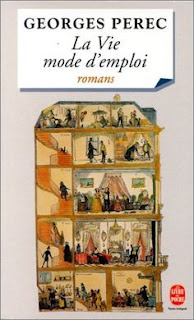Rereading the Manual
*
In Paris, the Rue Georges Perec etches the name of one of the greatest fiction writers ever on the cartography of the city. It is a tiny walkway, with a couple of sets of stairs and charming municipal lights. Located in a residential area in the XXth arrondissement (admin district), it seems like a street preferred by the gentry.
I pieced together such information from web searches as I began rereading Perec’s masterpiece, Life: A User’s Manual. The close to 600 pages of Life describe a single moment in the lives of the residents of a Paris apartment block. A single moment, yes! The omniscient narrator flits through the staircase, the flats, the rooms, the boiler room, the cellar, the garret, and so on, usually making an inventory of the objects present there, sometimes narrating the history of those objects, at other times connecting those histories to the lives of the characters.
The tenure of our lives is exclusive to us. Everything else that we encounter has a different timeline, a different expiry date. Perec is interested in how the haphazard commingling that constitutes our homes might be inexhaustible in the histories that it contains - a snapshot is an eternity!
There are multiple interesting narratives running throughout the work, related to each other like jigsaw pieces. The ending is enthralling. I remember how I couldn’t sleep the night I finished Life. It requires of the reader many times the work that a common great novel may require, but I recommend it to anyone looking for an experience of a lifetime.
The imaginary apartment block in the novel exists on the imaginary Rue Simon Crubellier, which is placed in the real XVIIth arrondissement of Paris. Perec locates it thus: “…cuts at an angle across the quadrilateral formed by Rue Médéric, Rue Jadin, Rue de Chazelles, and Rue Léon Jost…” My web searches led me to a map to see these four real streets form the quadrilateral across which no real street cuts.
Then, internet, as it is wont to, threw something interesting at me.
In a Youtube video dated 2008, two Australians search for Rue Simon Crubellier. Their quest is an artistic one: “Is it possible to bring something that does not exist into existence by searching for it?” They ask people on the four streets for directions to the imaginary street, and they get dismayed expressions. Looking at the video, I couldn’t help but chuckle, but I was also a bit sad that no one realized the joke, that no one on those Parisian streets was aware of how a great writer had memorialized them, ‘cut at an angle’ across them.
The relief came when a kid, perchance excited by the microphone carrying interlocutor, actually provided directions to Rue Simon Crubellier. And he did so with not a small degree of confidence. The gesture would have made Perec, who died of lung cancer in 1982 (at the unjust age of forty five), laugh in happiness.
I pieced together such information from web searches as I began rereading Perec’s masterpiece, Life: A User’s Manual. The close to 600 pages of Life describe a single moment in the lives of the residents of a Paris apartment block. A single moment, yes! The omniscient narrator flits through the staircase, the flats, the rooms, the boiler room, the cellar, the garret, and so on, usually making an inventory of the objects present there, sometimes narrating the history of those objects, at other times connecting those histories to the lives of the characters.
The tenure of our lives is exclusive to us. Everything else that we encounter has a different timeline, a different expiry date. Perec is interested in how the haphazard commingling that constitutes our homes might be inexhaustible in the histories that it contains - a snapshot is an eternity!
There are multiple interesting narratives running throughout the work, related to each other like jigsaw pieces. The ending is enthralling. I remember how I couldn’t sleep the night I finished Life. It requires of the reader many times the work that a common great novel may require, but I recommend it to anyone looking for an experience of a lifetime.
The imaginary apartment block in the novel exists on the imaginary Rue Simon Crubellier, which is placed in the real XVIIth arrondissement of Paris. Perec locates it thus: “…cuts at an angle across the quadrilateral formed by Rue Médéric, Rue Jadin, Rue de Chazelles, and Rue Léon Jost…” My web searches led me to a map to see these four real streets form the quadrilateral across which no real street cuts.
Then, internet, as it is wont to, threw something interesting at me.
In a Youtube video dated 2008, two Australians search for Rue Simon Crubellier. Their quest is an artistic one: “Is it possible to bring something that does not exist into existence by searching for it?” They ask people on the four streets for directions to the imaginary street, and they get dismayed expressions. Looking at the video, I couldn’t help but chuckle, but I was also a bit sad that no one realized the joke, that no one on those Parisian streets was aware of how a great writer had memorialized them, ‘cut at an angle’ across them.
The relief came when a kid, perchance excited by the microphone carrying interlocutor, actually provided directions to Rue Simon Crubellier. And he did so with not a small degree of confidence. The gesture would have made Perec, who died of lung cancer in 1982 (at the unjust age of forty five), laugh in happiness.
***



Comments
Post a Comment